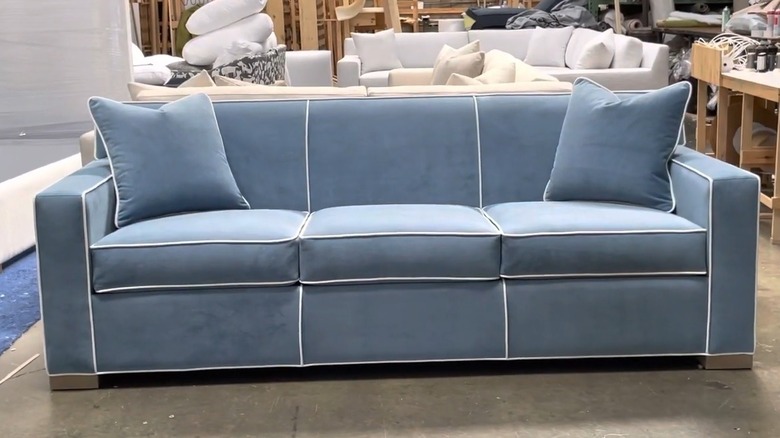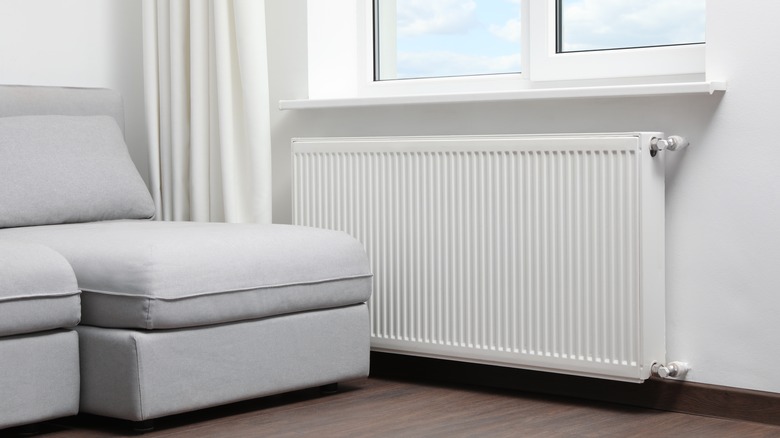Is The Sofa Piping Trend Right For Your Living Room?
Sofa piping is a trend that's essentially as old as human luxuries. Cushion Source notes that piping and welting on cushions were used in antiquity to denote status across European nobility classes. In the modern market for sofas, chairs, and other lounge furniture, piping and other decorative styles have lost this marker of old-world status, but retain a stylistic flair that's sure to turn heads.
Sofa piping became a huge trend in the 1970s and could be found in households across the United States. Since then, this decorative addition to the edges of your sofa cushions has lost a bit of its luster; yet in 2023, homeowners are returning with great vigor to this ornamental addition. Livingetc notes that sofa piping can be used as a type of contrast element in the same way that rugs, pictures on the wall, and throw blankets or pillows are used. Contrast is a crucial feature used to define discreet sections of a large room and as a means to develop intrigue in your home's design and a dynamic energy that permeates the space (via Hudson & Crane). Using color-based contrast or diverging with textures can add a unique element to your sofa that elevates the style of your entire room and makes it a more welcoming and enjoyable space.
However, sofa piping isn't for everyone. Deciding on whether you'll include it remains a personal and introspective choice.
Sofa piping brings a retro feel to your living space
Many homeowners want to bring a unique stylistic element into their households. The modern sofa offers much advancement in bodily support, automatic movement of features, and significant comfort upgrades over many older design techniques. However, modern sofas have become bland and tired-looking in the grand scheme of things.
Reconquering the aesthetic of your living room can be done with a relatively simple transformation of key elements, such as the humble sofa piping that adds an eye-catching dimension to the piece. Because this sofa feature enjoyed so much popularity during the '70s, adding piping can immediately transform your living room into a mecca of retro vibes with the addition of a few complementary acquisitions. DefineBottle suggests placing your focus on period-accurate end tables, cabinets, half-round tables, and rugs. It's also worth thinking about rounding out the sofa with brass or wooden legs to complete the picture.
This alteration is essentially non-reversable
While adding piping to your sofa or purchasing one that has it incorporated directly into the design can make for a retro and unique aesthetic in your living room, it should be noted that this alteration can't be easily changed. According to Sharon O'Connor, the director and founder of Vintique Upholstery, "the color, texture, and size of piping are important considerations. Piping cannot be changed at a later date unless the sofa, chair, footstool, or chaise is being recovered or reupholstered" (via Livingetc).
This means that you'll need to think long and hard about the texture or material used to create the piping and the color that you'll select as a highlight in the room. This also means that sofa piping isn't going to be for everyone. For homeowners who like the ability to incorporate consistent changes and stylistic alterations to their space, locking themselves into this decision can be problematic at best. Similarly, adding piping to your couch or purchasing one that incorporates it can certainly be done on its own, but the style shines brightest when paired with other retro-inspired features. If you aren't prepared to bring these additional elements into the style of your home, then you may be creating a feature that feels somewhat out of place.


